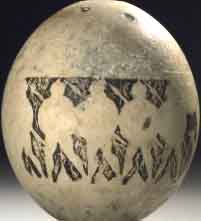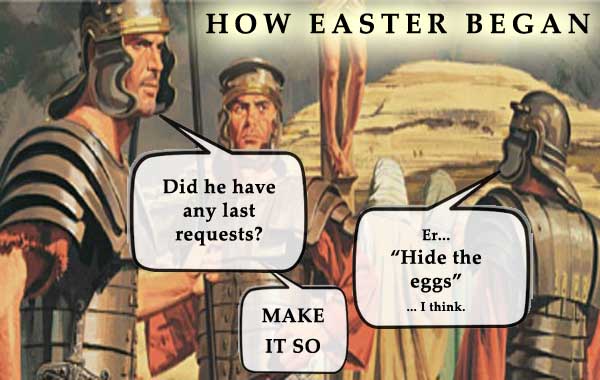Where do Easter Eggs Come From? What do Easter Eggs Mean?
https://www.humanreligions.info/easter_eggs.html
By Vexen Crabtree 2015
#china #chocolate_eggs #christianity #easter #easter_eggs #egg #eggs #egypt #greece #india #japan
 The symbol of the egg has been tied since time immemorial with the concepts of life, birth, rebirth, and in particular, with the time of spring1. It is deeply interwoven with prehistoric creation myths and ancient stories about the creation of life2,3. It has been given cosmic significance, representing the birth and rebirth of many gods and powerful spiritual beings, on account of its link to life and fertility2. The beloved chocolate egg has now come to be the ubiquitous and central image of Easter and the Easter holidays4.
The symbol of the egg has been tied since time immemorial with the concepts of life, birth, rebirth, and in particular, with the time of spring1. It is deeply interwoven with prehistoric creation myths and ancient stories about the creation of life2,3. It has been given cosmic significance, representing the birth and rebirth of many gods and powerful spiritual beings, on account of its link to life and fertility2. The beloved chocolate egg has now come to be the ubiquitous and central image of Easter and the Easter holidays4.
- The Egg is a Prehistoric and Global Symbol of Life and Rebirth
- Christian Easter Eggs
- Chocolate Easter Eggs
- The True Meaning of Easter
- Links
1. The Egg is a Prehistoric and Global Symbol of Life and Rebirth

The symbol of the egg has been tied since time immemorial with the concepts of life, birth, rebirth, and in particular, with the time of spring and a classic and comprehensive study of this symbol is the 1971 work by Venetia Newall.1. It "has aroused feelings of wonder in cultures all over the world" and has been deeply interwoven with creation myths and stories of the creation of life2. In Japan, China, India, Egypt, Europe and amongst the natives of the Americas and Polynesians (and lots of places in between), the egg has been given cosmic significance on account of its link to life and fertility2,3. For example, the Greek god of salvation and resurrection, Dionysus employed the symbol of the egg - he was depicted holding an egg in a terracotta bust dating from 380-360BC5.
“Egg: [...] In traditional folk religion the egg is a powerful symbol of fertility, purity, and rebirth. It is used in magical rituals [...] to encourage the growth of crops [...]. All over the world, it represents life and creation, fertility and resurrection. [...] In early times eggs were interred with the dead. Later they were linked with Easter. The church did not oppose this, though many egg customs were pre-Christian in origin.”
“Easter: [...] Among the most familiar Easter symbols are the egg and rabbit. The egg symbolizes new life breaking through the apparent death (hardness) of the eggshell. Probably a pre-Christian symbol, it was adapted by Christians to denote Christ's coming forth from the tomb. In many countries the exchange of coloured or decorate eggs at Easter has become customary.”
"The Encyclopedia of Religion" by Eliade Mircea (1987)2,6
“Throughout the world, the egg is a central symbol of recreation as well as creation. [...] In the Greek cult of Orphism, notable for its belief in the concept of salvation and the immortality of the soul, the egg symbolized the hope of reincarnation.”
"1001 Symbols" by Jack Tresidder (2003)5
2. Christian Easter Eggs
#christianity #germany #poland
Due to their popularity in representing life and rebirth in nature, eggs "[became] linked with Easter. The church did not oppose this, though many egg customs were pre-Christian in origin"2. The Christian use of egg symbolism around Easter began at an unknown date - probably in the 4th century. One of the earliest possible clues is that "two goose eggs adorned with stripes and dots were found in a grave at Worms, Germany, dated 320 CE. Scholars are not sure whether this grave was the site of a Christian burial"2.
Although it is very hard to tell if those engaging in easter-egg symbolism are doing so from Christian mores, secular joviality, or from a continuation of pagan rites, is hard to tell. In Poland the custom of preparing eggs for Easter had begun "before the eleventh century"2. The household accounts of King Edward I of England, in 1290CE, records him spend eighteen pence on purchasing and decorating 450 eggs with colours and gold leaf, which were to be given to the royal entourage at Easter2,4. It became a solid and expected tradition amongst the highest echelons of Christian society - "two centuries later young Henry VIII received one enclosed in a silver case as a seasonal present from the Vatican"4. These indulgent and elaborate gifts became a sign to outsiders that the Catholic Church's wealth and opulence had betrayed its Christian roots, and as Protestant Christianity was actively rejecting such materialism and rejecting non-Biblical Catholic traditions that they suspected were really based on paganism, in some Protestant areas "any customs involving eggs at Easter were avoided as Catholic"7.

3. Chocolate Easter Eggs

The chocolate Easter egg is one of those annual commercial-fests which has come to be the central feature4 of Easter for nearly all families in the West. Large shop displays become ubiquitous starting from a month before Easter time, and the variety of colours, shapes, sizes and exquisiteness of the products is staggering. This colourful and child-pleasing aspect is originally the creation of John Cadbury in 1875 when he 'launched the first commercial chocolate egg'8. Nowadays, it is hard to imagine any chocolatier who does not produce chocolate Easter eggs at Easter.

“After 1850, however, artificial specimens began to be made in the capital, and by 1874, the Illustrated London News could remark upon their growing popularity. It was only in the mid-twentieth century, however, that the chocolate Easter egg became mass-produced and took up its now ubiquitous role as the national symbol of the feast. It fitted perfectly into the now familiar pattern of the conversion of a former religious and communal celebration into one centred upon the family, and, more particularly, the pleasures of children.”
"The Stations of the Sun: A History of the Ritual Year in Britain" by Ronald Hutton (1996)4
The images displayed on Easter eggs, aside from brand logos, concentrate on the eggs themselves, fields, pastures and natural open spaces, and bunny rabbits, all of which represent natural fertility and natural abundance, which are the ancient historical themes of Easter time.
4. The True Meaning of Easter
#christianity #easter #easter_bunny #easter_eggs #jesus #moon #paganism #spring_equinox #sun
“The word Easter might have derived from a springtime Anglo-Saxon fertility goddess called Eastre (known as Eostre, in German and in Norse as Ostara), whose symbolism included the hare, the moon and eggs9. But that figure is disputed, and others say it derives from the word 'east', 'dawn'10 or from the Norse word for the spring season6. Easter is steeped in the symbolism of cycle of the sun, which rises in the East, and which in spring fondles the natural world to life. In the Northern Hemisphere, the spring equinox occurs on the 21st of March when the length of the day increases until it is equal with the length of the night11. The sun, growing in power, finally overtakes darkness, and this solar rebirth is celebrated in most ancient pagan religions, where agricultural life depended on the growth of spring. The other symbol of ancient solar superstition was the moon; and even today, Christians still celebrate their version of Easter on the first Sunday on or after the first Full Moon after the March equinox, tying Easter to its historical pagan roots. The images of Easter include two of the most ancient and universal symbols of birth, nature, fertility, life and rebirth: the egg and the rabbit1,2,12,3. We told anthropomorphized stories to explain why the sun, and nature, waxed and waned with the seasons, and thus Adonis, Attis, Dionysus, Osiris and many other Greek and Roman cults celebrated the death and rebirth of their gods at this time of year13. Since the very first centuries CE Christian apologists have had to defend themselves against accusations that the Jesus story was a retelling of pagan myths13. The beloved chocolate egg has now come to be the ubiquitous and central image of Easter and the Easter holidays4, and the Easter Bunny can often be seen delivering (and hiding) them, reminding us that Easter is a pagan, sun-worshipping festival.”